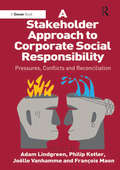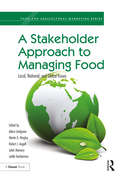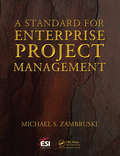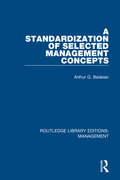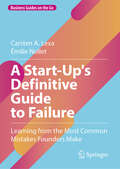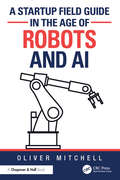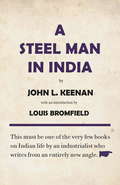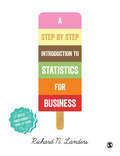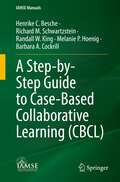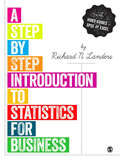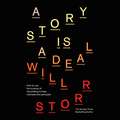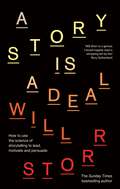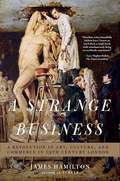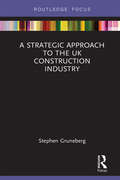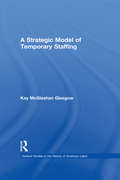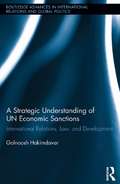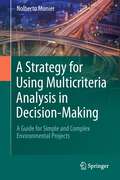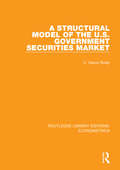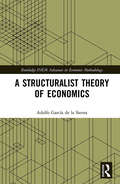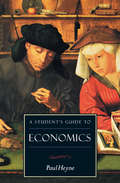- Table View
- List View
A Stakeholder Approach to Corporate Social Responsibility: Pressures, Conflicts, and Reconciliation
by Philip Kotler François MaonCorporate social responsibility has grown into a global phenomenon that encompasses businesses, consumers, governments, and civil society, and many organizations have adopted its discourse. Yet corporate social responsibility remains an uncertain and poorly defined ambition, with few absolutes. First, the issues that organizations must address can easily be interpreted to include virtually everyone and everything. Second, with their unique, often particular characteristics, different stakeholder groups tend to focus only on specific issues that they believe are the most appropriate and relevant in organizations' corporate social responsibility programs. Thus, beliefs about what constitutes a socially responsible and sustainable organization depend on the perspective of the stakeholder. Third, in any organization, the beliefs of organizational members about their organization's social responsibilities vary according to their function and department, as well as their own managerial fields of knowledge. A Stakeholder Approach to Corporate Social Responsibility provides a comprehensive collection of cutting-edge theories and research that can lead to a more multifaceted understanding of corporate social responsibility in its various forms, the pressures and conflicts that result from these different understandings, and some potential solutions for reconciling them.
A Stakeholder Approach to Managing Food: Local, National, and Global Issues (Food and Agricultural Marketing)
by Adam Lindgreen Martin K. Hingley Robert J. Angell Juliet MemeryThis research anthology explores the concept of food production and supply, from farm gate to plate, bringing together contemporary thinking and research on local, national, and global issues from a stakeholder perspective. A Stakeholder Approach to Managing Food includes a number of sections to represent these challenges, opportunities, conflicts, and cohesions affecting relevant stakeholder groups within food production and supply and their reaction to, engagement with, and co-creation of the food environment. For some, local, national, and global interests may seem at odds. We are in an era of growing and pervasive multi-national corporations, and these corporations have significant influence at all levels. Rapidly growing economies such as China are a focus for the global brand, but is this a scenario of adaptation or homogenization of food? Alongside this trend toward national and global development in food, this volume presents the counter-reaction that is taking place (especially in developed countries) toward local speciality and culturally bound foods, with emphasis on the importance of the inter-connection of local communities and agri-food culture and economy. With an in-depth analysis of agricultural businesses, this book shows that the entrepreneurial spirit is alive and well in rural communities with often renewed and engaged connection with consumers and imaginative use of new media. This book will be of interest to students, researchers and policy-makers concerned with agriculture, food production and economics, cultural studies.
A Standard for Enterprise Project Management (Esi International Project Management)
by Michael ZambruskiFrom enterprise vision and mission to business requirements to project initiation and management to operations, this practical guide explains each of the basic elements needed for project success and integrates them into a balanced life-cycle continuum. It includes a decision tree for determining the most appropriate level of project documentation, describes an integrated risk management and escalation policy, and contains more than two dozen templates and completed samples of key project management tools, such as a comprehensive statement of work template. The author offers a color version of the book.
A Standardization of Selected Management Concepts (Routledge Library Editions: Management #7)
by Arthur G. BedeianOriginally published in 1986. Since "modern" management’s beginning at the turn of the twentieth century, there have been pleas from management practitioners and academics alike to solidify the underlying foundation upon which it is based. However, until the field of management can boast of an all-inclusive and unified body of management theory, it will continue to remain without such a needed and desired framework. Confusion, controversy, and disagreement are traditionally characteristic of a new and growing field of study. The field of management is no exception. A large extent of the basic controversy and confusion associated with management thought can be attributed to disagreement over concepts and terminology. This absence of agreement and the resulting lack of standardization associated with it are the problems addressed by this study. Its purpose has been to undertake a thorough analyses of selected management concepts in an effort to: (1) clarify the meaning of these concepts by tracing their evolutionary development, (2) initiate a standardization of the fundamental terminology and definitions used in the field of management, (3) provide a beginning lexical soiree for additional future development and compilation of management terminology, and (4) contribute to the first and perhaps most vital step in the process of creating a valid and universally accepted general theory of management.
A Start-Up's Definitive Guide to Failure: Learning from the Most Common Mistakes Founders Make (Business Guides on the Go)
by Carsten A. Lexa Émilie NolletSeven out of ten start-ups fail. The reasons for failure are well-known. Yet founders often fail to approach the topic of failure with the seriousness and commitment it deserves. This book aims to change that and offers a new approach for founders to “drive their start-up off a cliff.” Structured as a “how-to guide to failure,” it highlights the most common mistakes founders make, explains where they come from, and illustrates them with real-life examples. The goal of the book is to help founders make the “right” mistakes in order to fail more efficiently (and perhaps help them avoid making these mistakes in the first place). The book includes an interview with German “start-up legend” Prof. Günter Faltin.
A Startup Field Guide in the Age of Robots and AI
by Oliver MitchellLaunching a startup is like climbing a mountain, just maybe more treacherous. I say this as I have spent years as a backpacker and entrepreneur. While hiking through the Alaskan Tundra, I feared brown bears and crevasses. Yet, nothing prepared me for the responsibility of payroll for over 200 families relying on my business plan to feed their children.Unlike traditional software, the mere smell of hardware sensors and robot gearing sends shivers through most investors, with red flags arising from the perceived capital inefficiencies and intense research and development. This is coupled with a high talent requirement before launching even a minimum viable product, as these inventions demand a cross-section of skills: mechanical, electrical, and software engineering. To set out on the trail of uncrewed success, machine inventors and founders require a detailed field guide to meet customer demand and financing objectives.My goal for this book is to help you at a pivotal point in your ideation process and, at the same time, introduce you to a cadre of potential mentors. Through interviews with some of the most respected luminaries in this field, I aim to help fortify your resolve to follow your passions and build a billion-dollar company. The chapters of this book have been organized like a field guide, as if you are setting out on a trip in the wild. Just like it’s essential to satiate yourself before scaling mountains, fast-tracking your innovation into the hands of early adopters is vital for achieving success on Main Street.
A Steel Man in India
by John L. KeenanWhen Jamsetji Nusserwanji Tata announced his plan to set up a steel plant in India, sceptical Englishmen immediately proclaimed that they were ready to eat all the steel that India would produce. This is the story of how Tata made them eat their words ? told by the man Tata hired to make it happen. Tata, Keenan declares, was a man with a vision, who saw that India must produce steel to be free and to survive in the modern world. With American engineers and Indian capital, he transformed a corner of the old feudal India into the new industrial India, and Keenan did a great deal to help him. Now a business classic, A Steel Man in India is a riveting account by a man of parts: who, in between his `chota pegs?, horse racing and elephant fights, soaked up Hindi and Urdu, and was a typical representative of the spirit that contributed to the making of a modern India.
A Step Ahead: Competition Policy for Shared Prosperity and Inclusive Growth
by Begazo Gomez Georgiana Pop Martha Martinez Licetti Sara NymanSustainable economic development has played a major role in the decline of global poverty in the past two decades. There is no doubt that competitive markets are key drivers of economic growth and productivity. They are also valuable channels for consumer welfare. Competition policy is a powerful tool for complementing efforts to alleviate poverty and bring about shared prosperity. An effective competition policy involves measures that enable contestability and firm entry and rivalry, while ensuring the enforcement of antitrust laws and state aid control. Governments from emerging and developing economies are increasingly requesting pragmatic solutions for effective competition policy implementation, as well as recommendations for pro-competitive sectoral policies. A Step Ahead: Competition Policy for Shared Prosperity and Inclusive Growth puts forward a research agenda that advocates the importance of market competition, effective market regulation, and competition policies for achieving inclusive growth and shared prosperity in emerging and developing economies. It is the result of a global partnership and shared commitment between the World Bank Group and the Organisation for Economic Co-operation and Development (OECD). Part I of the book brings together existing empirical evidence on the benefits of competition for household welfare. It covers the elimination of anticompetitive practices and regulations that restrict competition in key markets and highlights the effects of competition on small producers and employment. Part II of the book focuses on the distributional effects of competition policies and how enforcement can be better aligned with shared prosperity goals.
A Step-By-Step Introduction to Statistics for Business
by Mr Richard N LandersA clear and concise introduction to statistics for business and management students, demonstrating how important statistics are in the business decision-making process and covering everything from conducting a survey and collecting data, to summarizing statistical data, and presenting findings. Each chapter features a real-world business situation and accompanying dataset, the reader is then encouraged to identify the correct statistical concept in the chapter and solve the problem outlined. Offering students a chance to use the newly learned theory in a practical way. New to the second edition: A “Review of Essential Mathematics” prologue, featuring tests and further links to help students refresh their knowledge of the core mathematical concepts used to calculate basic statistics. Updated screenshots on using IBM SPSS and Excel. A “Statistics in the Real World” feature included at the end of each chapter, demonstrating how statistics are applied in real-world business settings and research, accompanied by reflective questions. Updated case studies, examples and diagrams, illustrating key points and helping to reinforce learning. The book is accompanied by free online resources including step-by-step video tutorials on how to use Excel and IBM SPSS, datasets and worked solutions, an Instructors’ Manual, Testbank, and PowerPoint presentation slides for lecturers. Essential reading for business students wanting to know how to use statistics in a business setting.
A Step-By-Step Introduction to Statistics for Business
by Mr Richard N LandersA clear and concise introduction to statistics for business and management students, demonstrating how important statistics are in the business decision-making process and covering everything from conducting a survey and collecting data, to summarizing statistical data, and presenting findings. Each chapter features a real-world business situation and accompanying dataset, the reader is then encouraged to identify the correct statistical concept in the chapter and solve the problem outlined. Offering students a chance to use the newly learned theory in a practical way. New to the second edition: A “Review of Essential Mathematics” prologue, featuring tests and further links to help students refresh their knowledge of the core mathematical concepts used to calculate basic statistics. Updated screenshots on using IBM SPSS and Excel. A “Statistics in the Real World” feature included at the end of each chapter, demonstrating how statistics are applied in real-world business settings and research, accompanied by reflective questions. Updated case studies, examples and diagrams, illustrating key points and helping to reinforce learning. The book is accompanied by free online resources including step-by-step video tutorials on how to use Excel and IBM SPSS, datasets and worked solutions, an Instructors’ Manual, Testbank, and PowerPoint presentation slides for lecturers. Essential reading for business students wanting to know how to use statistics in a business setting.
A Step-by-Step Guide to Case-Based Collaborative Learning (IAMSE Manuals)
by Barbara A. Cockrill Henrike C. Besche Richard M. Schwartzstein Randall W. King Melanie P. HoenigThis book is about Case-Based Collaborative Learning (CBCL) for medical educators. CBCL combines elements from team-, case- and problem-based based learning using a flipped classroom model. This book presents a detailed “how to” guide on how to create CBCL classroom materials, how to facilitate vivid discussions, and how to support students and faculty in a CBCL curriculum. The first chapter explores the CBCL method in context of established educational principles. The second chapter provides a step-wise guide to creating CBCL teaching materials from scratch or adapting existing resources. Chapter three discusses how to support both - faculty and students - in making the most out of in-class case discussions. The last chapter explores modifications to the CBCL method that have evolved over time in adapting to teaching remotely, as well as promoting self-directed learning skills in students. While originally developed in context of undergraduate medical education, the CBCL method is of interest to anyone in higher education that values flipped classroom methods and discussion-based teaching.
A Step-by-Step Introduction to Statistics for Business
by Mr Richard N LandersThe essential introduction to statistics for business students , this book will equip you with the knowledge and skills required to succeed in your studies and use statistics in your workplace. In a clear and engaging way, Richard Landers guides the reader through the vital role statistics play in the business decision-making process and carefully explains and demonstrates how they are applied in practice. The book covers everything from collecting data to summarising your findings and presenting them. It also revisits all the basic maths skills required to work with data and statistics effectively, with step-by-step screenshot illustrations in both Excel and IBM SPSS. Chapters open with an example of a common business situation which then runs throughout the chapter, encouraging the reader to identify appropriate solutions to real-world quantitative questions. Each chapter concludes with a second example and discussion for you to test your newly gained statistics knowledge. The book also comes with a comprehensive Companion Website which hosts: - Click-by-click video tutorials for how to use Excel and IBM SPSS - Unlimited datasets and worked solutions for practicing your statistics skills - A full instructor's manual with in-class activities plus PowerPoint presentations for lecturers. Visit the Companion Website at www.sagepub.co.uk/landers Electronic inspection copies are available for instructors.
A Story is a Deal: How to use the science of storytelling to lead, motivate and persuade
by Will StorrIn this highly anticipated follow-up to the Sunday Times bestseller The Science of Storytelling, acclaimed story guru Will Storr shows you how to engage and influence your audience to create irresistible pitches, build passionate brand loyalty, motivate teams and lead with effectiveness and charisma. Using the latest findings from social psychology, evolutionary psychology, organisational psychology and neuroscience, A Story is a Deal argues that we won't unlock the true power of story if we treat it merely as something we read on a page, see on a screen or hear in a speech. Storr shows how successful stories shape identities, which changes beliefs, drives action and achieves extraordinary results. With examples ranging from Aztec rituals to Apple's legendary advertising successes (and long-forgotten fails), A Story is a Deal lays out a revolutionary new method for creating the most persuasive messaging: by harnessing the power of our storytelling brains.
A Story is a Deal: How to use the science of storytelling to lead, motivate and persuade
by Will StorrIn this highly anticipated follow-up to the Sunday Times bestseller The Science of Storytelling, acclaimed story guru Will Storr shows you how to engage and influence your audience to create irresistible pitches, build passionate brand loyalty, motivate teams and lead with effectiveness and charisma. Using the latest findings from social psychology, evolutionary psychology, organisational psychology and neuroscience, A Story is a Deal argues that we won't unlock the true power of story if we treat it merely as something we read on a page, see on a screen or hear in a speech. Storr shows how successful stories shape identities, which changes beliefs, drives action and achieves extraordinary results. With examples ranging from Aztec rituals to Apple's legendary advertising successes (and long-forgotten fails), A Story is a Deal lays out a revolutionary new method for creating the most persuasive messaging: by harnessing the power of our storytelling brains.
A Story is a Deal: How to use the science of storytelling to lead, motivate and persuade
by Will StorrIn this highly anticipated follow-up to the Sunday Times bestseller The Science of Storytelling, acclaimed story guru Will Storr shows you how to engage and influence your audience to create irresistible pitches, build passionate brand loyalty, motivate teams and lead with effectiveness and charisma. Using the latest findings from social psychology, evolutionary psychology, organisational psychology and neuroscience, A Story is a Deal argues that we won't unlock the true power of story if we treat it merely as something we read on a page, see on a screen or hear in a speech. Storr shows how successful stories shape identities, which changes beliefs, drives action and achieves extraordinary results. With examples ranging from Aztec rituals to Apple's legendary advertising successes (and long-forgotten fails), A Story is a Deal lays out a revolutionary new method for creating the most persuasive messaging: by harnessing the power of our storytelling brains.
A Strait of Uncertainty: Taiwan's Development in the Shadow of China
by William C. Kirby Tracy Yuen Manty Yuanzhuo Wang J. Megan GreeneRelations between the People's Republic of China (PRC), on the Chinese Mainland, and the Republic of China (ROC), on Taiwan, had improved significantly since 2008. Taiwan investment in China had played a major role in China's economic boom in recent decades. Investments, partnerships, study, travel, and marriages across the Strait pointed to a future of ever-greater interaction between two parties that brought Asia to the brink of war three times in the last half-century (1954, 1958, 1996). But what does the future hold? Will Taiwan thrive and yet maintain its autonomy as a part of the broader economy of "Greater China"? Will economic integration lead, inexorably, to Taiwan's incorporation into the People's Republic of China? Or will the 2016 electoral backlash in Taiwan against integration with the Mainland embolden the new Taiwan leadership to seek a future for Taiwan separate from China?
A Strange Business: Making Art And Money In Nineteenth-century Britain
by James HamiltonBritain in the nineteenth century saw a series of technological and social changes which continue to influence and direct us today. Its reactants were human genius, money and influence, its crucibles the streets and institutions, its catalyst time, its control the market. In this rich and fascinating book, James Hamilton investigates the vibrant exchange between culture and business in nineteenth-century Britain, which became a center for world commerce following the industrial revolution. He explores how art was made and paid for, the turns of fashion, and the new demands of a growing middle-class, prominent among whom were the artists themselves. While leading figures such as Turner, Constable, Landseer, Coleridge, Wordsworth, and Dickens are players here, so too are the patrons, financiers, collectors and industrialists; publishers, entrepreneurs, and journalists; artists' suppliers, engravers, dealers and curators; hostesses, shopkeepers and brothel keepers; quacks, charlatans, and auctioneers. Hamilton brings them all vividly to life in this kaleidoscopic portrait of the business of culture in nineteenth-century Britain, and provides thrilling and original insights into the working lives of some of the era's most celebrated artists.
A Strategic Approach to the UK Construction Industry
by Stephen GrunebergThe construction industry is a microcosm of the economy as a whole, and as such the economics of the sector contains many of the aspects of the economy in general, albeit with fascinating and unique features. What are the implications of economic theory for the future of UK construction? How does the industry ensure innovation, quality and efficiency? What priorities might best serve the construction industry, those working in it and their customers? In seeking answers to these and other questions, the UK government has commissioned a number of reports on the construction industry including the Latham and Egan reports and more recently Construction 2025. These have invariably proposed time and cost targets for the construction industry. In this new book, Stephen Gruneberg stands in stark contrast to those reports and presents the relevant theoretical aspects of construction economics to account for the behaviour of construction firms and suggest a strategy for future growth and sustainability. He discusses the theory and data relating to the output of firms in relation to the type of firm, the market and how these firms behave as a result. The purpose of this book is to advocate the measures needed to create the kind of industry that must be fostered to ensure the quality of its output, sustainability and the fair terms and conditions of employment for its workforce. Gruneberg’s new book is essential reading for anyone wishing to understand the economic forces that determine industry outcomes and who has a stake in the success of the UK construction sector.
A Strategic Model of Temporary Staffing (Garland Studies in the History of American Labor)
by Kay GlasgowThis book examines the relationship between competitive strategies and the use of temporary employees.
A Strategic Understanding of UN Economic Sanctions: International Relations, Law and Development (Routledge Advances in International Relations and Global Politics)
by Golnoosh HakimdavarEconomic Sanctions are increasingly used as a legal, non-military technique of combating abusers of international peace. However it remains unclear how the success or failure of these sanctions is measured. This book examines the seldom-explored United Nations’ economic sanctions deliberation process and exposes systematic problems in the measurement of the success or failure of these sanctions. Centering on the key concepts of "peace and security," the author brings the reader’s attention to the discrepancies that exist in the process of decision-making, implementation, and evaluation of UN imposed economic sanctions. She engages international law and development methods to provide proof for the lack of consensus in measures of success and failure, which in turn suggests that sanction implementation on a uniform domestic front are unattainable. This thorough analysis concludes with suggestions for improving the sanctions process, only to clear the path for negating them as a whole and suggest alternative non-coercive measures for mitigating conflict situations and threats to peace and security.
A Strategy for Using Multicriteria Analysis in Decision-Making: A Guide for Simple and Complex Environmental Projects
by Nolberto MunierThis book develops a whole strategy for decision-making, with the full participation of the decision-maker and utilizing continuous feedback. It introduces the use of the very well-known and proven methodology, linear programming, but specially adapted for this purpose. For this, it incorporates a method to include subjective concepts, as well as the possibility of working with many different and even contradictory objectives. The book is liberally populated with diverse case studies to illustrate the concepts. This practical guide will be of interest to anyone undertaking analysis and decision-making, on both simple and complex projects, and who is looking for a strategy to organize, classify, and evaluate the large amount of information required to make an informed decision. The strategy includes methods to analyze the results and extract conclusions from them.
A Structural Model of the U.S. Government Securities Market (Routledge Library Editions: Econometrics #14)
by V. Vance RoleyOriginally published in 1979. This study focuses primarily on the development of a structural model for the U. S. Government securities market, ie. the specification and estimation of the demands for disaggregated maturity classes of U.S. Government securities by the individual investor groups participating in the market. A particularly important issue addressed involves the extent of the substitution relationship among different maturity classes of U.S. Government securities.
A Structuralist Theory of Economics (Routledge INEM Advances in Economic Methodology)
by Adolfo García de la SienraEconomists have long grappled with the problem of how economic theories relate to empirical evidence: how can abstract mathematized theories be used to produce empirical claims? How are such theories applied to economic phenomena? What does it mean to “test” economic theories? This book introduces, explains, and develops a structural philosophy of economics which addresses these questions and provides a unifying philosophical/logical basis for a general methodology of economics. The book begins by introducing a rigorous view of the logical foundations and structure of scientific theories based upon the work of Alfred Tarski, Patrick Suppes, Karl Marx, and others. Using and combining their methods, the book then goes on to reconstruct important economic theories – including utility theory, game theory, Marxian economics, Sraffian economic theory, and econometrics – proving all the main theorems and discussing the key claims and the empirical applicability of each theory. Through these discussions, this book presents, in a systematic fashion, a general philosophy of economics grounded in the structural view. Offering rigorous formulations of important economic theories, A Structuralist Theory of Economics will be invaluable to all readers interested in the logic, philosophy, and methodology of economics. It will also appeal particularly to those interested in economic theory.
A Student's Guide To The Internal Revenue Code (Sixth Edition)
by Jeffrey A. Maine Richard GershonThis Guide book does not teach substantive tax law, which constantly changes, but rather the language of tax, which largely remains constant. Thus, a student who learns how to read the Internal Revenue Code effectively will be able to understand each new tax reform. To that end, A Student's Guide to the Internal Revenue Code: • Examines statutory organization and language; • Introduces basic tax constants to provide a frame of reference from which to view tax law, no matter what future tax reform might bring; • Teaches how to use and research the cases, regulations, and Internal Revenue proclamations; • Provides numerous problems and exam questions which students can use to test their ability to apply the language of the Internal Revenue Code; and • Provides sample answers to problems and exams for students to monitor their progress.
A Student's Guide to Economics (ISI Guides to the Major Disciplines)
by Paul HeyneWhat makes economies work—or not work? This concise overview of the field&’s great thinkers offers a wealth of information. Paul Heyne, one of the nation&’s best-selling economists, provides an accessible overview of the discipline of economics. Economic knowledge, he contends, is not complete without reference to the totality of human society—a realization essential to a proper understanding of the fundamental principles of economics. The sweep of economic thinking is presented here with reference to the great economists and important schools of thought.
